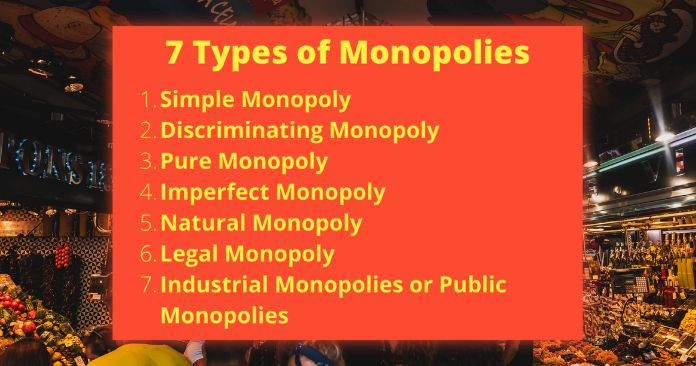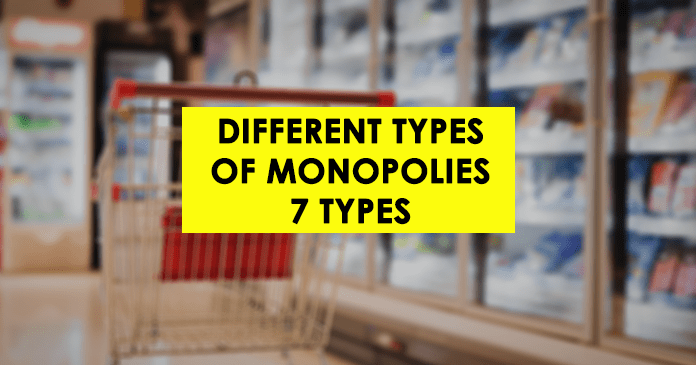Do you want to know the different types of monopolies? There are seven types of monopoly market structures namely simple monopoly and discriminating monopoly, natural monopoly, legal monopoly, pure monopoly, imperfect monopoly, industrial monopolies or public monopolies.
A monopoly is a market situation where there is only one seller of products. Therefore, both the industry and firm in this market is one. Hence, there are barriers for a new producer to enter the market. Further, imperfect information is a prominent feature in this market.
The general characteristics of all the monopoly types are as follows.
- Monopoly is one of the market structures among other markets like perfect competition, monopolistic competition and oligopoly. Monopoly differs from these structures especially due to its outstanding and absolute market power.
- In monopoly, both producer and Apart from that, monopoly producer does not real information to another party. This product has no close substitutes either. This characteristic creates different monopoly structures like pure monopoly and imperfect monopoly.
- There is only one seller in this market and its products are homogeneous.
- Unlike in competitive market where there is a separate industry and many firms, monopoly has only one firm which is the price-maker and not price taker.
- Since there are many buyers and one seller, no one can influence the price. Hence, a monopolist treats all consumers in an equal way and charges a uniform price for the product.
Let’s explore these monopoly structures separately as follows.

1. Simple Monopoly
This is one of the monopoly markets structures. Here, a simple monopoly firm charges a uniform price for its products when selling to all its buyers. A simple monopoly operates in a single market with a single price, unlike a discriminating monopoly that operates in more than one market.
Examples: water supply, railway services
2. Discriminating Monopoly
Price differentiation is a special power that a monopoly enjoys. It bases its objective on profit maximization. Monopoly can either choose to price differentiation and quantity differentiation.
In either way, a monopoly gets to maximize its profit. Why a simple monopoly differs from a discriminating monopoly is that the discriminatory monopoly firm charges different prices for the same product to different buyers.
Therefore, a discriminatory monopoly, as the name suggests, discriminate its buyers in different markets with different prices.
3. Different Types of Monopolies: Pure Monopoly
This particular type of monopoly differs from all the other monopoly types because the substitutes available for the product in pure monopoly is zero.
This means that pure monopolies do not even have a remote substitute. Therefore, the power centred around a pure monopoly is immense. No matter how unfair the pure monopoly price is, the buyers will have to stick to that price.
However, pure monopoly is a rare phenomenon. Instead, there are imperfect monopolies all around the world. The imperfect monopoly has a limited degree of monopoly power to exercise.
Example: A special kind of medicine that is produced only by one and only producer
4. Imperfect Monopoly
Imperfect monopoly is a single firm that produces a commodity having no close substitutes. The degree of Monopoly power is less than the perfect monopoly or the pure monopoly.
In imperfect monopolies, it is easier for buyers to shift to a close substitute than in pure monopoly. This market is commonly existent in the real world.
5. Different Types of Monopolies: Natural Monopoly
This monopoly market has something to do with natural benefits. It can occur due to reasons like specialisation or availability of natural resource etc.
Therefore, natural monopoly is a case that arises due to natural causes. It also has common monopoly characteristics such as producing a unique good, price and quantity differentiation and entry barriers etc. Natural monopoly offers the industry with a
special benefit of producing the product at a lower cost. This particular instance supports them to win a larger part of the market.
Example: Canada has a natural monopoly nickel production while India has got Monopoly in mica production at present.
6. Legal Monopoly
This particular situation arises when anybody receives or acquires monopoly power due to legal provisions in the country. In general, patents, trademarks and copyrights safeguards products from an unauthorised use of a third party.
Such provisions are assured by law and vest special powers on the hands of the producer or the person who owns the so-called patents, trademarks or copyright.
Once copyright protection or trademark protection is available, the law forbids the potential competitors to imitate the form and design of products registered under the given brand names, or trademarks.
The purpose of granting such patents and copyrights is to safeguard the interests of innovators who have done much research and undertaken risks of innovating particular products.
Example: Company A has obtained a patent to produce particular electric equipment, therefore it has power against other companies to defend its product from other companies.
7. Industrial Monopolies or Public Monopolies
Industrial or public monopolies arise as a result of government action. Governments may nationalize some industries in public sectors in the general interest of the nation.
Example: In 1956 The Indian Industrial Policy Resolution for example, emphatically lays down that certain sectors like atomic energy, arms and ammunition, railways and air transport will be
the exclusive monopoly of the Central Government.
Therefore, it is clear that industrial monopolies arise as a result of statutory measures.
Different types of monopolies: Summery
The term monopoly includes two parts; mono means single while poly means the seller. Hence monopoly is a market where there is a single seller with absolute monopoly power.
There are different types of monopolies such as simple monopoly and discriminating monopoly, pure monopoly and imperfect monopoly, natural monopoly, legal monopoly, industrial monopolies or public monopolies.
Some of these structures are often existent in the real world. However, markets like pure monopolies are extremely rare in real world. Because there are at least two industries that produce the same good. It is a duopoly where two industries work with monopoly traits.
As a whole, monopolies are markets where competition is low. Therefore, the absolute power is on the producer and the buyer has a limited choice and power in the market.


